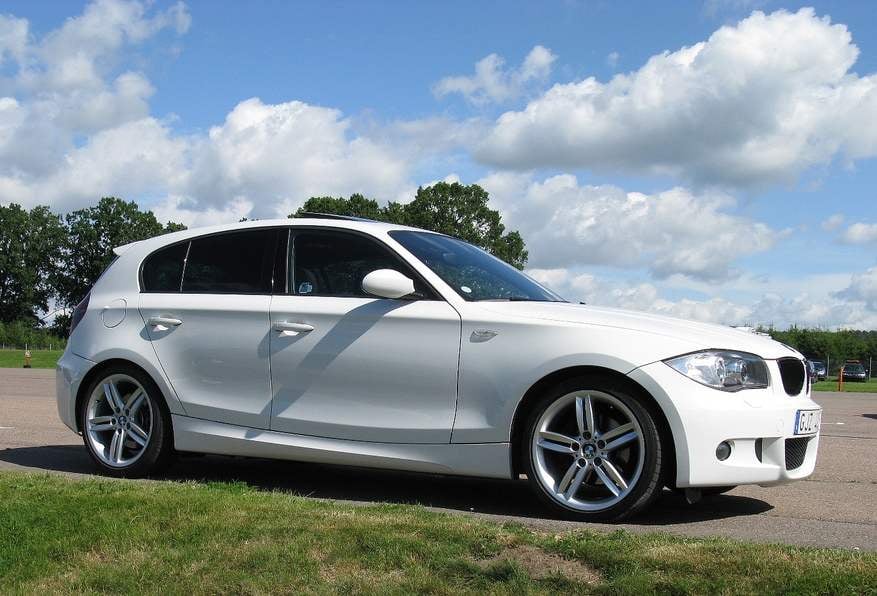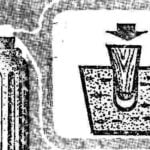 BMW 1 series new car-class Golf. When in 1974, the company Volkswagen has released a compact front wheel drive VW GOLF, it was hard to imagine that this tiny three-door hatchback small class, the exterior of which was designed by the great Italian designer Giorgetto Giugiaro, will be the founder of a giant class of vehicles, called by the name of the very first “Golf course”. The reason for this was the tremendous popularity of cars in this class — for the first nine years of production of the VW GOLF they were released 6.8 million copies.
BMW 1 series new car-class Golf. When in 1974, the company Volkswagen has released a compact front wheel drive VW GOLF, it was hard to imagine that this tiny three-door hatchback small class, the exterior of which was designed by the great Italian designer Giorgetto Giugiaro, will be the founder of a giant class of vehicles, called by the name of the very first “Golf course”. The reason for this was the tremendous popularity of cars in this class — for the first nine years of production of the VW GOLF they were released 6.8 million copies.
For the first VW GOLF with the same demand followed by a second, third, fourth, fifth… To the “Golf tournament” was joined by other automotive firms — everyone wanted to grab a piece of the income pie of the popularity of these the most popular cars. It is enough to mention a modern AUDI A3, OPEL ASTRA, PEUGEOT 307, TOYOTA COROLLA, FORD FOCUS and many other cars in this class. Overall for the year in Europe sold about 12 million of these machines.
Until recently, however, in “Golf championship” has not attended such a famous company like BMW (Bayerische Motorenwerke) — level prestige produced its machinery did not fall below the BMW 3-series referring to cars older class. However, in 1994, the firm was attempting to create a reduced version of the BMW 316i COMPACT designed to compete with cars of a class “Golf”. However, the shortened “three” and in size, and the price is still significantly different from classmates VW GOLF. Besides the three-door car provided comfort only to the driver and front seat passenger rear with the convenience they could be only children, In 2002, took place the update compact BMW, but buyers of cars in this class are not too eager to acquired a shortened version of “treshek”.
And finally, another attempt of the Bavarian firm to become a full member of the “Golf tournament”. This time it was much more serious — Bayerische Motorenwerke BMW released the 1 SERIES, the car of a Golf class with a truly unique design, full of numerous devices borrowed from their more prestigious models.
The leaders of the firm were presented for approval seven versions of the machine exterior and four interior. From all this diversity was selected the facilities, worked out the main interior designer of the BMW SERIES 1 mark Gerard, in combination with the exterior design proposed by designer Chris Chapman.

Predecessor the BMW 1-series — shortened three-door “three”-BMW 316i hatchback COMRAST release 1994

The CD version of “treshki” next — generation three-door hatchback BMW 316ti COMPACT

New car Golf class of the company Bayerische Motorenwerke — BMW SERIES 1
When you create a “unity” designers Bayerische Motorenwerke not have to repeat the classic layout of machines of a Golf class — front-wheel drive with a transverse engine layout. Instead, it used traditional cars BMW concept chassis with a longitudinally mounted engine and rear-wheel drive, ensuring a perfect weight distribution of 50-50%, the longest base in its class and wider track. It is for a BMW rear wheel drive has traditionally been the key to thrilling dynamics, excellent traction and solid handling.
It should be noted that the progressive front-wheel drive concept is implicitly accepted by almost all makers of cars of a Golf class, is not so spotless, as is commonly believed. Its main drawback is the influence of the actuator on the steering. The compact BMW 1-series, the flaw is completely absent.
Uniform weight distribution also improves the dynamic qualities of the BMW 1-series, contributing to an optimal handling: quick driving on winding road, the centrifugal force evenly act on the front and rear wheels, which provides excellent directional stability and high manoeuvrability.
The car’s dynamic qualities are directly linked to the suspension design. For “unity” has been re-designed five-link rear suspension that meets the highest requirements not only to dynamics but also to the smoothness. Steel light-weight design and rigid structure with straight arms in the form of rods with short shoulders provide the precision guide system of the suspension of the wheel, creating the optimal conditions for the overall dynamic settings of the car. By the way, this same suspension will be equipped with the new “three rubles,” the release of which is expected in 2005.
Equally successful is the design of the front suspension McPherson double-joint with a traction stretch, suspension struts and a stabilizer, which provides high control accuracy (by the way, the same suspension is made for more modern prestigious “five” BMW). Made mostly of aluminum alloys, it has extremely high rigidity despite its very low weight.
Powertrains fitted to the BMW 1-series, are at the level of the latest achievements. The first time the car will be sold with four-cylinder engines: two petrol and two diesel, which is a modified powertrain of the modern “three rubles” BMW.

The geometric scheme of the BMW SERIES 1

The steering position BMW SERIES 1

The engine of the BMW 1 SERIES is equipped with air regulation valve lift
Capacity petrol engines ranging from 115 HP in the BMW 116i to 150 HP in the BMW 120i. Incidentally, the latter are equipped with infinitely variable adjustment of valve stroke and valve timing, allowing the engines become the epitome of efficient dynamics: they are designed as possible a large power output at high revs, and the optimized values of fuel consumption in the partial load range.
Impress with their traction and exceptional smoothness and diesel engines, equipped with Common Rail injection system, turbocharger with variable turbine geometry and cooling system charge air. Diesel engines develop power from 122 HP in the BMW 118d to 163 HP BMW 120d. Use in the construction of these engines balance shafts have significantly reduced noise and vibration.
Torque from the engine to the wheels is transmitted via a manual five-or six-speed manual gearbox (five-speed on the BMW 116i) or six-speed automatic transmission with Steptronic feature (automatic — for 120i and 120d). It should be noted that BMW 1 series on road performance is the leader in its segment of cars.
In the design of the BMW SERIES 1 issue of passenger safety was given the utmost attention. In particular, when creating the body was a new, particularly strong grades of steel, giving the frame an extraordinary rigidity. And arising from the collision voltage is programmed to cause the deformation of the elaborate system of spars and cross beams. Due to this, the salon is fully protected from deformation, and the load on the passengers are minimized.
Advanced security also contributed three-point inertia seat belts, head restraints on all seats, front airbags with two stages of operation as well as front side airbags and pillows and curtains that protect from injuries like vaditaja and rear passengers. To intensify and coordinate the operation of airbags, pretensioners and force limiters the front seat belts using the latest control system, which, depending on the intensity and type of kick sends signals for triggering the individual elements. Thus, when an accident involves only those elements of security that are needed. In particular, in a collision off the battery, turns off fuel pump, rasplachivayutsya door locks included emergency signal light and interior lighting.
BMW 1-series is also equipped with numerous active safety for avoiding accidents. In particular, this compact car has the stability control (DSC), which helps to keep the car on the desired course, for example, when the detour of unexpectedly arisen obstacles. Thanks to the purposeful intervention in the operation of the brakes of the individual wheels prevents the breakdown of the vehicle in a slide. A driver with sporting ambitions in the DSC system has a working mode with a higher threshold the beginning of the slide.
Reliable traction on rough terrain provides traction control (ASC), which corresponds to a traditional locking differential. In addition to the system dynamic braking control (DBC) is special for cornering (CBC) and electronic brake force distribution (EBV), which complements the features of the systems of control of stability DSC and ABS. Together they represent a unique class for the compact package of active safety features that do not impede the enjoyment of driving a car.

Comparative scheme of the German cars of a Golf class

Front (A) rear (B) suspension of a BMW SERIES 1
Safe tires Run Flat in the base, not afraid of punctures and capable of zero in pressure to drive up to 150 km without any damage to the wheel rim as well as indication of an air leak in the tires (RPA), a warning about the dangerous pressure drops in them, are additional safety margins, providing effortless management the BMW 1-series.
BMW SERIES 1 was the first machine of a Golf class on the German car market, equipped with two-stage brake lights. The purpose of this upgrade has already been successfully introduced on other BMW models, is to reduce the risk of rear-end collision: a particularly bright flash stop signal that warns drivers of following vehicles about the dangerous situation. Under normal braking illuminates a conventional brake light, and when the emergency is automatically activated a large illuminated surface that encourages other drivers to increased inhibition.
The brake system of the BMW 1-series is powerful and extraordinary efficiency. Due to the large brake discs front and rear wheels, the car has the best features of a slowdown in its class. In addition, higher reliability provides a continuous indication of brake lining wear that is new in the Golf class. The sensors detect their condition, then control unit taking into account driving style continuously calculates the mileage remaining until replacement of the pads and inform the driver. Constantly is determined by the remaining resource and other fast-wearing parts; information about it is displayed on a 6.5-inch colour display at the top of the front panel directly in the driver’s field of vision. In variant configuration without a color display is performed using the onboard computer, the screen of which is located between the speedometer and tachometer.
Inside the “unity” of the BMW more comfortably and can accommodate up to five people. Thanks to the folding rear seat and trunk, the amount of which depending on rear seat position is between 330 to 1150 liters, the five-door car can also not the usual transportation problem. The back door swings open to a height of 1.8 meters, facilitating loading. It is opened via either the remote control or handle with integrated BMW logo. Maximum payload 500 kg and a large range of volume changes of the trunk enhance the usability of the car, as well as numerous pockets and compartments, a double boot floor and the outlet in the rear compartment. For the first time in the Golf class BMW is dividing the grid in the trunk, which during emergency braking does not allow the cargo stacked in the back, shift forward, thus eliminating the danger to passengers.

Seat provide comfort and reliable support on long trips. A variety of adjustments designed for passengers of both large and small, include adjustment of the steering column in a horizontal and vertical plane, which allows riders to quickly find the most comfortable position.
Unique to the compact class is the position of the gas pedal, brake and clutch. Since the engine in the BMW is located longitudinally of the pedal managed to place right in front of the driver seat without a little offset to the right from the ideal position, as it usually happens on cars with transverse engine placement. So the driver easily finds the optimum for the active driving position behind the wheel of “unity.” A special element that until now was offered only in cars of higher classes with a pronounced sporty character, is the pneumatic backrest width adjustment seats, which at the push of a button provides optimal lateral support.
The BMW SERIES 1 is carried out continuous monitoring of the status of the battery. Once the sensor charge control unit registers the decrease of the battery capacity, there is capacity of secondary consumers — in particular those that provide comfort. The battery capacity does not drop below the value necessary to start the engine.
Comfort access allows the driver to start his BMW 1 series without taking the key out of his pocket, already when approaching the car key sends a signal of recognition. When you touch the door handle will automatically unlock and to start the engine, only one press of a button. It is curious that the car can recognize up to four users by their keys and automatically adjust important functions. As a result, when getting into the vehicle, the driver discovers that “unity” is fully complied with selected individual settings. The key automatically saves your most recent settings of the audio system, air conditioning and seats with electric adjustment and mirrors.
Technical characteristics of the car BMW 1-series

Eight days before the start of the build the buyer can choose an individual package of the BMW 1-series. A large number of coatings, materials and trim options trim, and also unusually wide for a compact-class range of options to create space for imagination. It is expected that the car will descend from the conveyor in accordance with the orders and, therefore, in exact accordance with the wishes of customers. The probability that during one year the factory left the two identical “unity”, practically zero.
Today in Golf class includes machines at times with a variety of parameters, and for convenience, the classification of the Golf class can be divided into segments, grouping them in the machine for some defining characteristics. The criterion of belonging to a particular segment can be the displacement of the engine, the geometric parameters of the vehicle, the maximum speed or, in the end, price. BMW 1 SERIES won in this class segment is the most prestigious and expensive models — marketing the company found out that the highest rates inside the Golf-class rising sales of such vehicles. I think that in Russia there are hunters to purchase a “real” BMW is the cheapest of the “ones”, the BMW 116i in the basic configuration with the 1.6-liter engine capacity of 115 HP, would cost in this country of 23 000 euros.
I. EVSTRATOV



